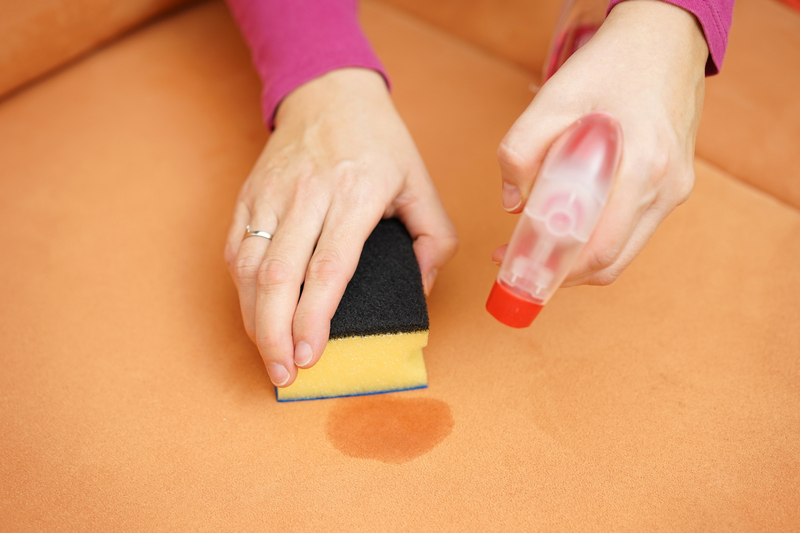Simple Steps to Banish Damp Aromas
Posted on 12/06/2025
Simple Steps to Banish Damp Aromas
Are musty odors lingering in your home or basement? The presence of damp aromas or persistent moisture smells can make any living space uncomfortable and unwelcoming. Fortunately, there are effective and simple steps to banish damp aromas permanently. This comprehensive guide will walk you through the causes, remedies, and preventive measures to ensure your home remains fresh and inviting.
Why Do Damp Aromas Occur?
Damp, musty smells are a clear indicator of excessive moisture in your environment. Understanding their origin is crucial for permanently eliminating damp aromas. Common sources include:
- Water leaks in pipes, roofs, or walls
- Poor ventilation causing trapped humidity
- Unsealed basements or crawl spaces
- Improperly dried laundry indoors
- Absence of regular cleaning in damp-prone areas
Mold and mildew thrive in such conditions, producing volatile organic compounds (VOCs) that contribute to the classic musty odor. Recognizing these sources is the first and most important step in your mission to remove damp smells effectively.

Assessing the Severity: When Is It an Emergency?
In some cases, damp aromas are not just unpleasant--they're a red flag for health hazards like black mold. If you notice:
- Visible black, green, or fuzzy mold growth
- Persistent respiratory symptoms among household members
- Peeling paint or wallpaper
- Standing water or extensive water damage
Call a professional immediately. For less severe cases, you can tackle the issue yourself by following these simple solutions for damp odors.
Simple Steps to Banish Damp Aromas
1. Identify and Eliminate the Source of Moisture
- Check for leaks: Inspect under sinks, behind appliances, and in less-frequented rooms for dripping pipes or water stains.
- Monitor humidity levels: Use a hygrometer to ensure household humidity stays below 60%.
- Ventilate: Regularly open windows and use exhaust fans in bathrooms and kitchens.
- Dry wet materials promptly: Wet carpets, clothes, and towels should never linger indoors.
Taking these actions stops new sources of dampness from feeding the problem and gives you a solid foundation for further eradication of musty smells.
2. Deep Clean Affected Areas
- Wash soft furnishings: Remove and wash curtains, linens, and cushion covers in hot water with a little white vinegar.
- Clean hard surfaces: Scrub floors, walls, and ceilings with a solution of water and milder vinegar or baking soda.
- Treat mold and mildew: For small patches, a mixture of 1 part hydrogen peroxide to 2 parts water works well. For larger infestations, seek professional help.
Deep cleaning ensures you're not just masking odors, but actually removing the microbial sources of damp aromas.
3. Use Natural Deodorizers to Eliminate Damp Smells
- Baking soda: Sprinkle on carpets, inside shoes, or in corners and vacuum after a few hours.
- Activated charcoal: Place bowls in musty areas to absorb both moisture and odors.
- White vinegar: Leave a cup out overnight to neutralize lingering smells.
- Coffee grounds: Set out in open containers to naturally absorb unwanted scents.
These simple deodorizers for damp environments are safe, effective, and eco-friendly.
4. Improve Air Circulation and Dehumidification
- Invest in a dehumidifier: Particularly effective for basements and closed rooms.
- Use fans: Box or oscillating fans help circulate air and reduce humidity build-up.
- Open doors and closets: Don't let stagnant air collect behind closed spaces.
Consistent air flow is a powerful ally in your quest to banish musty aromas for good.
5. Address Structural Issues
- Seal cracks and gaps: Examine walls, floors, and window frames, applying weatherproof sealants as needed.
- Upgrade insulation: Proper insulation helps prevent condensation on cold surfaces.
- Maintain gutters and downspouts: Keep them clear so water diverts away from your foundation.
These prevention steps are crucial to keep damp odors from returning.
6. Swap Out Old Materials
- Replace carpets or rugs: If they've been waterlogged or are old, it's best to switch them out.
- Renew underlay in basements: Damp-resistant materials can prevent future issues.
- Switch to anti-mold paint: Particularly valuable in bathrooms and kitchens.
Sometimes, elimination of persistent damp aromas is only possible by letting go of items that have absorbed years of humidity.
Pro Tips to Prevent Damp Odors Returning
With the main damp aromas removed, prevention is key. Adopt these habits for a fresher home:
- Dry laundry outdoors whenever possible
- Run bathroom and kitchen exhaust fans
- Use moisture absorbers: Silica gel packs, rock salt, or commercial products work well for closets and enclosed spaces
- Store items off the floor in basements and garages
- Regularly check areas prone to leaks, especially after storms
- Keep houseplants: Some, like Boston ferns and palms, can absorb humidity
Frequently Asked Questions About Damp Aromas and Their Removal
What is the fastest way to get rid of a musty odor?
Rapid results often come from combining thorough ventilation with powerful absorbents like activated charcoal and a deep cleaning spree using baking soda and vinegar. For quick fixes, open windows and run fans as you clean.
Are damp aromas dangerous?
While mild musty smells may not pose immediate health threats, chronic exposure--especially if mold is involved--can trigger allergies, headaches, respiratory issues, and worsen asthma. Always investigate persistent odors and consult professionals if necessary.
Can an air purifier help with damp odors?
Yes, air purifiers equipped with HEPA and carbon filters can significantly reduce musty odors and remove airborne mold spores. However, they should complement--not substitute--source removal and moisture control.
What if the damp smell persists?
If you've followed these simple steps to banish damp aromas and still notice persistent scents, investigate hidden mold in ducts, insulation, or behind wallpaper. Consider professional assessment, as invisible moisture issues could be present.
Natural vs. Chemical Damp Odor Removal: What's Best?
Natural solutions--such as vinegar, baking soda, and charcoal--are safe, cost-effective, and non-toxic, while chemical fresheners may only mask odors temporarily and could contain irritants. For stubborn cases, stronger mold-specific cleaners may be necessary, but always follow up with thorough ventilation.

Transform Your Home: The Benefits of a Fresh Environment
- Improved well-being: Musty, damp odors are linked to discomfort, sleep issues, and irritability. A fresh-smelling home enhances mood and relaxation.
- Healthier air quality: Eliminating damp and mold keeps allergens and toxins at bay.
- Long-term savings: Preventing moisture damage protects your property and possessions, saving on costly repairs.
- Increased property value: Homes free of damp aromas are much more appealing to buyers and visitors alike!
Conclusion: Embrace a Healthier, Fresher Living Space
No one deserves to live in a space tainted by damp aromas. By following these simple steps to banish musty and damp odors, you'll not only restore freshness, but also safeguard your family's health and your property's value. Remember to identify the source, clean thoroughly, use natural deodorizers, improve air flow, and address vulnerabilities in your home. Maintenance and vigilance are your best defenses.
Ready to reclaim your air? Start banishing damp aromas today--and enjoy a sparkling, welcoming home tomorrow!



